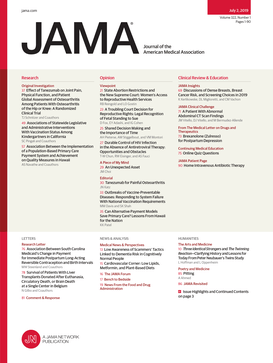JAMA facts for kids
 |
|
|
Former names
|
Transactions of the American Medical Association; Councilor's Bulletin; Bulletin of the American Medical Association; Journal of the American Medical Association |
|---|---|
|
Abbreviated title (ISO 4)
|
JAMA |
| Discipline | Medicine |
| Language | English |
| Edited by | Kirsten Bibbins-Domingo |
| Publication details | |
| Publisher |
American Medical Association (United States)
|
|
Publication history
|
1883–present |
| Frequency | 48/year |
|
Open access
|
Free access to research articles after six months |
|
Impact factor
(2023) |
63.1 |
| Indexing | |
| ISSN | 0098-7484 (print) 1538-3598 (web) |
| LCCN | 82643544 |
| CODEN | JAMAAP |
| OCLC no. | 1124917 |
|
Until 1960:
|
|
| ISSN | 0002-9955 |
| Links | |
|
|
JAMA (which stands for The Journal of the American Medical Association) is a very important medical journal. It is published 48 times a year by the American Medical Association. Think of it like a special magazine where doctors and scientists share new discoveries.
Before articles are published, they go through a process called peer-review. This means other experts in the same field check the articles carefully. They make sure the research is good and the information is correct. JAMA publishes new research, helpful reviews, and expert opinions about all parts of medicine and health.
The journal started way back in 1883. Nathan Smith Davis was its first editor. Today, Kirsten Bibbins-Domingo from the University of California San Francisco is the main editor. She took over on July 1, 2022. JAMA is considered one of the top medical journals in the world.
Contents
A Look at JAMA's History
JAMA began in 1883. It took the place of an older publication called Transactions of the American Medical Association. Over the years, its name changed a few times. For example, Councilor's Bulletin became the Bulletin of the American Medical Association.
Eventually, this bulletin joined with the Journal of the American Medical Association. In 1960, the journal got its current full name, JAMA: The Journal of the American Medical Association. Most people just call it JAMA for short.
How Doctors Keep Learning
For many years, JAMA helped doctors find ways to keep learning. This is called continuing medical education (CME). It helps doctors stay updated on new treatments and discoveries.
From 1937 to 1981, JAMA printed lists of CME opportunities. At first, there were about 1,000 options in 1955. By 1981, this grew to 8,500! In 2016, CME moved online. Now, doctors can get CME credit from articles and audio materials published across all 12 journals in the JAMA Network.
When a President Wrote for JAMA
On July 11, 2016, something very unusual happened. JAMA published an article written by Barack Obama. At the time, he was the U.S. president. This was the first time a sitting U.S. president had an academic paper published in a journal like this.
Usually, articles go through a "blind peer-review." This means the experts checking the article don't know who wrote it. However, President Obama's article was not reviewed this way. His article talked about health care reform in the United States. It also suggested ideas for future presidents to improve health care.
Ensuring Editorial Freedom
After a change in leadership in 1999, JAMA put new rules in place. These rules help make sure that the journal's editors can publish articles freely. This means they can choose what to publish without pressure from others.
A special committee was created with seven members. Their job is to check on the editor-in-chief and protect the journal's independence. This committee meets at least once a year. Today, JAMA's policy says that the ideas in an article belong to the authors, not the publisher.
Artwork on the Cover
From 1964 to 2013, JAMA used to feature images of artwork on its cover. They also published essays that explained the art. The idea was to connect art and medicine.
In 2013, the journal changed its design. The artwork moved to an inside page. The cover now shows a table of contents instead of a picture. This change helped make all the journals in the JAMA Network look more similar.
Past Editors of JAMA
Many important people have been the editor-in-chief of JAMA over the years. Here are some of them:
- Nathan S. Davis (1883–1888)
- John B. Hamilton (1889, 1893–1898)
- John H. Hollister (1889–1891)
- James C. Culbertson (1891–1893)
- Truman W. Miller (1899)
- George H. Simmons (1899–1924)
- Morris Fishbein (1924–1949)
- Austin Smith (1949–1958)
- Johnson F. Hammond (1958–1959)
- John H. Talbott (1959–1969)
- Hugh H. Hussey (1970–1973)
- Robert H. Moser (1973–1975)
- William R. Barclay (1975–1982)
- George D. Lundberg (1982–1999)
- Catherine D. DeAngelis (2000–2011)
- Howard C. Bauchner (2011–2021)
Where JAMA Articles Are Listed
JAMA articles are listed and summarized in many different databases. This helps researchers and doctors find the information they need easily. Some of these places include:
- Academic OneFile
- Academic Search
- BIOSIS Previews
- Biological Abstracts
- CAB Abstracts
- Chemical Abstracts
- CINAHL
- Current Index to Statistics
- Current Contents/Clinical Medicine
- Current Contents/Life Sciences
- Elsevier BIOBASE
- Embase
- Global Health
- Index Medicus/MEDLINE/PubMed
- PsycINFO
- Science Citation Index
- Scopus
- Tropical Diseases Bulletin
See also
- List of American Medical Association journals

